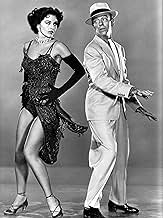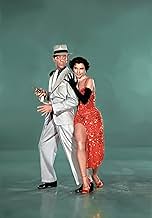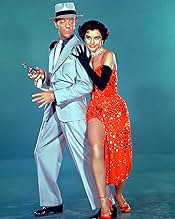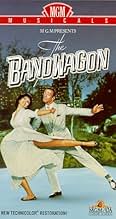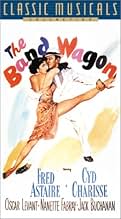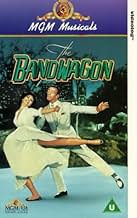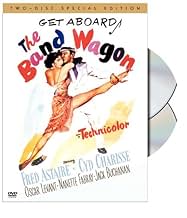VALUTAZIONE IMDb
7,4/10
13.300
LA TUA VALUTAZIONE
Un artistico e pretenzioso regista è assunto per un nuovo musical di Broadway, cambiandolo drasticamente.Un artistico e pretenzioso regista è assunto per un nuovo musical di Broadway, cambiandolo drasticamente.Un artistico e pretenzioso regista è assunto per un nuovo musical di Broadway, cambiandolo drasticamente.
- Regia
- Sceneggiatura
- Star
- Candidato a 3 Oscar
- 2 vittorie e 5 candidature totali
India Adams
- Gabrielle Gerard
- (voce (canto))
- (non citato nei titoli originali)
Fred Aldrich
- Hot Dog Vendor
- (non citato nei titoli originali)
Richard Alexander
- Stagehand
- (non citato nei titoli originali)
Ernest Anderson
- Train Porter
- (non citato nei titoli originali)
Barbara Bailey
- Dancer
- (non citato nei titoli originali)
Patsy Bangs
- Dancer
- (non citato nei titoli originali)
Lysa Baugher
- Dancer in Troupe
- (non citato nei titoli originali)
Mary Bayless
- Theatre Patron
- (non citato nei titoli originali)
Brandon Beach
- Auction Guest
- (non citato nei titoli originali)
Ralph Beaumont
- Dancer in Troupe
- (non citato nei titoli originali)
Don Beddoe
- Producer
- (non citato nei titoli originali)
Recensioni in evidenza
There are many shimmering moments in Bandwagon: Fred Astaire (playing a role close to his own life story; he was 53 at the time), the acidic wit of Oscar Levant ('that'll keep 'em laughing!!') tempered by the sunny Nanette Fabray and musical numbers including "Shine on Your Shoes," "I Guess I'll Have To Change My Plan," and a clever novelty trio called "Triplets." But the musical sequence that stands out the most is the one which has no vocal, no dialog, and gently advances the movie's plot of whether or not oil-and-water dancers Astaire and Cyd Charisse can actually perform together (when he thinks she's too tall and she thinks he's too old). Against a Central Park twilight, the film shows its heroes enjoy a hushed walk through a park (only an instrumental refrain of 'High and Low' is heard), after which they step into an empty courtyard (he in a pastel linen suit and spectator shoes, she in a flared white dress and ballet flats; a necessity to keep her from being taller than him on film) and into the pas-de-deux of "Dancing In The Dark." It's an exquisite sequence, which at times resembles courtship, foreplay, and ultimately a romantic climax- all done in dance. It ends, just as smoothly as it began, with the two leads spinning up a short flight of stairs and mounting a hansom cab, without a single hair out of place. Now THAT's entertainment.
Perhaps the finest hour of Fred Astaire and Cyd Charisse together (although Silk Stockings comes a close second); the 'Dancing in the Dark' sequence says it all about both this film, and the two impeccably classy stars.
There are, of course, other highlights - Oscar Levant and Nanette Fabray's acidic writers; Jack Buchanan's overblown producer; Fred's dance with the shoeshine boy, Le Roy Daniels; anything featuring Cyd Charisse - and those wonderful musical numbers, ranging from the anthem 'That's Entertainment' to the hilarious 'Triplets'.
'The Band Wagon' sends up the old film staple plot "putting on a show" and does it brilliantly, thanks to the crackling Comden/Green script. One of MGM's best musical efforts, hugely enjoyable.
There are, of course, other highlights - Oscar Levant and Nanette Fabray's acidic writers; Jack Buchanan's overblown producer; Fred's dance with the shoeshine boy, Le Roy Daniels; anything featuring Cyd Charisse - and those wonderful musical numbers, ranging from the anthem 'That's Entertainment' to the hilarious 'Triplets'.
'The Band Wagon' sends up the old film staple plot "putting on a show" and does it brilliantly, thanks to the crackling Comden/Green script. One of MGM's best musical efforts, hugely enjoyable.
The Bandwagon may yet prove to be the best of backstage musicals. It certainly is Fred Astaire at his best, probably his best film when he did not partner with Ginger Rogers.
Arthur Freed had great success with two previous song catalog musicals, An American In Paris with the music of George Gershwin and Singing in the Rain which utilized the songs that he wrote with Nacio Herb Brown. His source for this film were the songs of Howard Dietz and Arthur Schwartz.
Dietz and Schwartz were an interesting pair of writers. Howard Dietz worked right at MGM in their publicity department. In fact it was Dietz who invented MGM's famous Leo the Lion. Song lyrics were in fact an avocation. Arthur Schwartz was a lawyer who just one day gave up the practice of law to devote himself to songwriting. They wrote some of the best music of the Thirties. After which Dietz devoted himself to publicizing MGM and Schwartz worked with other lyricists.
They wrote revues and this is where the source material for The Band Wagon comes from. In fact one of their revues was entitled The Band Wagon and starred none other than Fred and Adele Astaire. However the team got together again and wrote one new number for the film, the legendary That's Entertainment.
This The Band Wagon is not a revue. The plot concerns an aging musical film star Fred Astaire, talked into coming east by husband and wife writing team Nanette Fabray and Oscar Levant. They want him to do a Broadway show to revive his career. They get Broadway wunderkind Jack Buchanan to direct it and later on classical ballet star Cyd Charisse to team with Astaire.
Buchanan is outrageously funny as he first tries to get them to do an avant garde musical about the Faust saga. When that flops, he's a good enough trooper to put ego aside and do some serious rewriting. And this man certainly has one Texas size ego. According to a book on the Arthur Freed musicals, Buchanan was in a lot of pain from arthritis and doing some of those numbers, especially Triplets was agony for him.
That was not the only problem on the set. It was a pretty grim place. Oscar Levant had suffered a heart attack before the production and he was ten times his normal hypochondriac self. And Fred Astaire's wife was terminally ill at home.
Cyd Charisse gauging the mood of her fellow cast members just kept to herself, but Nanette Fabray who is an exuberant personality did not go over well as Miss Perky. She recorded it was one of her worst film experiences.
Still this monumental triumph of a film got made. My favorite of all the numbers besides That's Entertainment is the soft shoe duet that Fred Astaire and Jack Buchanan partner in. It's all grace and elegance and so typically Fred Astaire. And it's probably what most people know of Jack Buchanan. Over in the United Kingdom he was a leading stage and screen performer. Until The Band Wagon was made he was probably best known to American audiences as Jeanette MacDonald's leading man in Monte Carlo.
Cyd Charisse dances divinely as she always does, never better than in the finale, The Girl Hunt Ballet with Astaire. I still wonder why she never starred at MGM with her husband Tony Martin.
When one is asked what the American musical film ideal is, one of the best answers you can give is The Band Wagon.
Arthur Freed had great success with two previous song catalog musicals, An American In Paris with the music of George Gershwin and Singing in the Rain which utilized the songs that he wrote with Nacio Herb Brown. His source for this film were the songs of Howard Dietz and Arthur Schwartz.
Dietz and Schwartz were an interesting pair of writers. Howard Dietz worked right at MGM in their publicity department. In fact it was Dietz who invented MGM's famous Leo the Lion. Song lyrics were in fact an avocation. Arthur Schwartz was a lawyer who just one day gave up the practice of law to devote himself to songwriting. They wrote some of the best music of the Thirties. After which Dietz devoted himself to publicizing MGM and Schwartz worked with other lyricists.
They wrote revues and this is where the source material for The Band Wagon comes from. In fact one of their revues was entitled The Band Wagon and starred none other than Fred and Adele Astaire. However the team got together again and wrote one new number for the film, the legendary That's Entertainment.
This The Band Wagon is not a revue. The plot concerns an aging musical film star Fred Astaire, talked into coming east by husband and wife writing team Nanette Fabray and Oscar Levant. They want him to do a Broadway show to revive his career. They get Broadway wunderkind Jack Buchanan to direct it and later on classical ballet star Cyd Charisse to team with Astaire.
Buchanan is outrageously funny as he first tries to get them to do an avant garde musical about the Faust saga. When that flops, he's a good enough trooper to put ego aside and do some serious rewriting. And this man certainly has one Texas size ego. According to a book on the Arthur Freed musicals, Buchanan was in a lot of pain from arthritis and doing some of those numbers, especially Triplets was agony for him.
That was not the only problem on the set. It was a pretty grim place. Oscar Levant had suffered a heart attack before the production and he was ten times his normal hypochondriac self. And Fred Astaire's wife was terminally ill at home.
Cyd Charisse gauging the mood of her fellow cast members just kept to herself, but Nanette Fabray who is an exuberant personality did not go over well as Miss Perky. She recorded it was one of her worst film experiences.
Still this monumental triumph of a film got made. My favorite of all the numbers besides That's Entertainment is the soft shoe duet that Fred Astaire and Jack Buchanan partner in. It's all grace and elegance and so typically Fred Astaire. And it's probably what most people know of Jack Buchanan. Over in the United Kingdom he was a leading stage and screen performer. Until The Band Wagon was made he was probably best known to American audiences as Jeanette MacDonald's leading man in Monte Carlo.
Cyd Charisse dances divinely as she always does, never better than in the finale, The Girl Hunt Ballet with Astaire. I still wonder why she never starred at MGM with her husband Tony Martin.
When one is asked what the American musical film ideal is, one of the best answers you can give is The Band Wagon.
10latics
Just saw this again, for the first time in 10 years. What a show! This is unquestionably the last of the great line of MGM and, therefore, Hollywood musicals . . . the last real flowering of Arthur Freed's genius at holding together a team of top production talents which had produced such a fine string of musicals. Not a dull spot in the entire movie and tremendous style in Minnelli's direction. Nice to see Jack Buchanan getting a last chance in the spotlight his top hat routine with Astaire is one of the highlights of the movie. Astaire himself, playing the fading musical star which he was by 1953, has a magnificent opening with two contrasting numbers the wistful By Myself and the exuberant Shine on your Shoes tailored to set up his character perfectly. The Girl Hunt ballet is, of course, the dancing highlight of the movie and it is here that the utterly wonderful Cyd Charisse comes into her own. Apart from being arguably the best female dancer in Hollywood history, she was certainly the most beautiful: the scene in the ballet in which she appears on a bar stool and slips off her coat to reveal a dramatic red dress oozes with as much sex appeal as any movie moment I've ever seen.
Director Vincente Minnelli is probably the most important star of the visually stunning film "The Bandwagon". Betty Comden and Adolph Green supplied the book and most of the songs, aided by Arthur Schwartz and Alan Jay Lerner. And the relationships, as anyone who has worked in theater can attest, are unusually understated and true. The primary story-line concerns Tony Hunter, a man who has had failures in film and has now returned to Broadway looking for a good project. His old friend portrayed by Nanette Fabray and Oscar Levant have a project in mind. But they make the mistake of hiring an ambitious director who sees in their tale a vehicle for a Faustian allegory filled with deep meanings, fire, brimstone, explosions and necrophiliac lighting. Of course the musical they produce is a total failure; and Tony has been compelled to dance with a hired ballerina, with whom he finds himself falling hopelessly in love. In desperation, he suggests they go back to the original show and not disband. As a result they craft a success, Tony gets his girl and everything ends happily. This I find to be a first-rate MGM production, using its top personnel: cinematography by Henry Jackson, art direction by Preston Ames and Cedric Gibbons, sets by Edwin Willis and Keogh Gleason, Sydney Guilaroff's hairstyles and William Tuttle's makeup, and costumes by Mary Ann Nyberg. The stars of the film are all very professional and likable. Fred Astaire is Tony, Cyd Charisse the ballerina, Nanette Fabray andOscar Levant as ilmic Comden and Green stand-ins, Jack Gardner, James Mitchell, Robert Gist, and many others in small or uncredited roles including familiar faces such as Herb Vigran, Barbara Ruick, Julie Newmar, et al. Some have complained that the musical numbers here seemed a bit static or curiously cold; but this is a musical for once where the numbers look as if they could have been musical numbers onstage; and after chasing this film for decades, when I saw it I was delighted by its stunning visual qualities; and as a theatrical veteran I was also gratified that its human relationships seemed to work, as theatrical portraits by Comden and Green and in the personages who people this very enjoyable entertainment.
Lo sapevi?
- QuizIn the DVD bonus features, Nanette Fabray stated that Oscar Levant was difficult to work with. Whenever something would go wrong or he would make a mistake, he would blame whoever was around. This included stage hands, other actors, lighting technicians, or whoever was handy. She said that, since she was usually closest, she caught the brunt of it. Following a botched take, he again blamed her for something. She lost her temper and told him off using unladylike language. Everyone on the set applauded. After that, he was much easier to work with.
- BlooperAt the New York opening night, the theater name on the marquee is Alcott Theatre, but the program cover has Stratton Theatre.
- Citazioni
Gabrielle Gerard: Oh, that's a very early Degas, isn't it?
[examines painting]
Gabrielle Gerard: 1877.
Tony Hunter: [playing up their age difference] Yeah, I swiped it from his desk in school. Was he sore.
- Versioni alternativeThere is an Italian edition of this film on DVD, distributed by DNA srl, "THE BAND WAGON (Spettacolo di varietà, 1953) - New Widescreen Edition + IL SIGNORE IN MARSINA (1943)" (2 Films on a single DVD, with "The Band Wagon" in double version 1.33:1 and 1.78:1), re-edited with the contribution of film historian Riccardo Cusin. This version is also available for streaming on some platforms.
- ConnessioniEdited into Hollywood: The Dream Factory (1972)
- Colonne sonoreBy Myself
(1937) (uncredited)
Music by Arthur Schwartz
Lyrics by Howard Dietz
Performed by Fred Astaire twice
I più visti
Accedi per valutare e creare un elenco di titoli salvati per ottenere consigli personalizzati
Dettagli
- Data di uscita
- Paese di origine
- Lingue
- Celebre anche come
- Brindis al amor
- Luoghi delle riprese
- 214 West 42nd Street, Manhattan, New York, New York, Stati Uniti(establishing shot showing the New Amsterdam Theatre)
- Azienda produttrice
- Vedi altri crediti dell’azienda su IMDbPro
Botteghino
- Budget
- 2.169.120 USD (previsto)
- Lordo in tutto il mondo
- 15.009 USD
- Tempo di esecuzione
- 1h 52min(112 min)
- Proporzioni
- 1.33 : 1
Contribuisci a questa pagina
Suggerisci una modifica o aggiungi i contenuti mancanti




